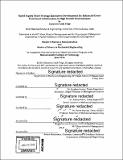| dc.contributor.advisor | Stephen Graves and Abbott Weiss. | en_US |
| dc.contributor.author | Voigt, Clararose Faith | en_US |
| dc.contributor.other | Leaders for Global Operations Program. | en_US |
| dc.date.accessioned | 2016-09-13T19:18:44Z | |
| dc.date.available | 2016-09-13T19:18:44Z | |
| dc.date.copyright | 2016 | en_US |
| dc.date.issued | 2016 | en_US |
| dc.identifier.uri | http://hdl.handle.net/1721.1/104262 | |
| dc.description | Thesis: S.M., Massachusetts Institute of Technology, Department of Mechanical Engineering, 2016. In conjunction with the Leaders for Global Operations Program at MIT. | en_US |
| dc.description | Thesis: M.B.A., Massachusetts Institute of Technology, Sloan School of Management, 2016. In conjunction with the Leaders for Global Operations Program at MIT. | en_US |
| dc.description | Cataloged from PDF version of thesis. | en_US |
| dc.description | Includes bibliographical references (pages 77-78). | en_US |
| dc.description.abstract | Like companies from almost every industry, NIKE faces a marketplace that is transitioning toward e-commerce. Over the next five years, retail sales through NIKE.com are anticipated to grow meteorically. For NIKE specifically, this shift represents a change not only in where and how consumers shop, but also a significant transformation of NIKE's underlying business model. NIKE has historically derived the majority of its revenue from wholesale accounts, representing 76% of its revenue in FY15.1 The evolution from wholesale brick-and-mortar sales to online retail sales requires substantial changes across NIKE's supply chain and manufacturing strategies to better serve the online consumer's ever-increasing service, quality and product offering expectations and to capture the revenue and gross-margin upsides of vertically-integrated retail. Given the ripple effects of this business model shift that will affect every part of NIKE's business, NIKE Global Operations leadership seeks to identify data-driven solutions that support cross-channel, cross-function collaboration to capture end-to-end insight. The key objective of this thesis is to identify simulation capabilities and development processes that will help supply chain leaders get to enhanced enterprise insight, faster. Thus, the goals of this research are two-fold: 1) Develop general end-to-end simulation capability and user needs assessments, and 2) Develop proof-of-concept simulators that integrate cross-functional metrics and business drivers, and enable rapid 'what-if scenario generation and comparison. After identifying user needs regarding both simulation capabilities and simulator content, two proof-of-concept simulations were developed from critical cross-functional business questions posed by a wide array of interviewed stakeholders. The first simulation presents a holistic framework for understanding liquidation supply and demand in the context of digital's forecasted growth. The second simulation concept presents a framework for selecting products with optimal characteristics for onshore/near-shore advanced manufacturing. Both concepts demonstrate that data and organizational integration is both feasible and desirable within the supply chain strategy planning process, and that simulation tools are valuable investments that can provide enriched insight above current processes. | en_US |
| dc.description.statementofresponsibility | by Clararose Faith Voigt. | en_US |
| dc.format.extent | 78 pages | en_US |
| dc.language.iso | eng | en_US |
| dc.publisher | Massachusetts Institute of Technology | en_US |
| dc.rights | M.I.T. theses are protected by copyright. They may be viewed from this source for any purpose, but reproduction or distribution in any format is prohibited without written permission. See provided URL for inquiries about permission. | en_US |
| dc.rights.uri | http://dspace.mit.edu/handle/1721.1/7582 | en_US |
| dc.subject | Mechanical Engineering. | en_US |
| dc.subject | Sloan School of Management. | en_US |
| dc.subject | Leaders for Global Operations Program. | en_US |
| dc.title | Rapid supply chain strategy simulation development for enhanced cross-functional collaboration in high growth environments | en_US |
| dc.type | Thesis | en_US |
| dc.description.degree | S.M. | en_US |
| dc.description.degree | M.B.A. | en_US |
| dc.contributor.department | Leaders for Global Operations Program at MIT | en_US |
| dc.contributor.department | Massachusetts Institute of Technology. Department of Mechanical Engineering | |
| dc.contributor.department | Sloan School of Management | |
| dc.identifier.oclc | 958159239 | en_US |
